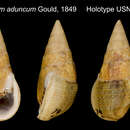Comprehensive Description
(
englanti
)
tarjonnut Smithsonian Contributions to Zoology
Clypeomorus adunca (Gould)
Cerithium aduncum Gould, 1849:119 [holotype: USNM 5567; type-locality: Mindanao, Philippines]; 1852:147; 1856, pl. 10: fig. 167a,b; 1862:61, 245.—Sowerby, 1865, pl. 9: fig. 57.—Tryon, 1887:139, pl. 26: figs. 96, 97.—Kobelt, 1895:186, pl. 34: fig. 8.—Schepman, 1909: 162.—Johnson, 1964:38.
Cerithium dorsuosum A. Adams in Sowerby, 1855:867, pl. 181: figs. 130–140 [lectotype, here selected, BMNH, not registered; type-locality: Misamis, Mindanao, Philippines; not Cerithium dorsuosum Menke, 1828]; 1865, pl. 9; fig. 56a,b.—Tryon, 1887:139, pl. 26: fig. 97.—Kobelt, 1893: 103–104, pl. 20: figs. 9–10.
DESCRIPTION.—Shell (Figure 53; Table 31): Adult shell thick, turreted, moderately elongate, reaching 17.5 mm in length, with teleoconch of 6 or 7 whorls having apical angle of 30 degrees. Length/width index 2.01. Adult whorls nearly straight sided, smooth overall, but incised with numerous fine spiral lines. Former varices present, prominent varix on dorsal surface of body whorl. Body whorl inflated, flattened on aperture side. Aperture ovate, nearly one-fourth the length of the shell. Anterior siphonal canal short, straight, and deep. Columella concave with slight callus. Anal canal deep, defined by posterior columellar plait, and extending posteriorly onto penultimate whorl. Outer lip thick and smooth, but interiorly lirate. Outer lip extends nearly two-thirds over side of penultimate whorl. Plane of aperture tangential with shell and passes through the apex, giving shell distorted look and causing it to “bend” ventrally. Suture incised, distinct, and straight. Shell color white, variably blotched or striped with brown or gray; sometimes completely brown. Aperture normally white. Protoconch unknown. Periostracum not seen. Operculum thick, corneous, tan, ovate, and paucispiral with eccentric nucleus. Rugose attachment scar on lower half of obverse of operculum.
Radula (Figure 54): Radular ribbon tiny, fragile, and with 90 rows of teeth, in animal with shell length of 22 mm. Shell length/radula length index 5.81. Rachidian tooth (Figure 54b,c) pentagonal, about 30 μm wide. Top of rachidian tooth with sharp concave depression. Cutting edge has 1 large pointed median cusp flanked on each side with 2 blunt denticles. Basal plate of rachidian tooth flat with thin horizontal ridge at its center and with a small median pointed projection at its base. Lateral tooth (Figure 54b,c) rhomboidal with extremely long basolateral projection that tapers where it is inserted onto radular membrane. Top of lateral tooth flat, bearing large rounded central cusp flanked on each side by smaller pointed denticle. Basal plate of lateral tooth bearing median pointed projection. Marginal teeth (Figure 54d) long, spatulate with curved tips. Tip of inner marginal has a large spoon-shaped central median cusp flanked on inside by 2 smaller blunt denticles and on outside by single small denticle. Outer marginal identical but lacking outer denticle.
Animal: (This description is based on one poorly preserved animal and is not complete.) Animal cream colored except for dark brown snout and tentacles. Mantle papillae at inhalant siphon longer and darker. Under surface of inhalant siphon dark colored and wrinkled with longitudinal folds. Osphradium prominent. Ctenidium and hypobranchial gland brown. Kidney appears to consist of a single lobe. Buccal mass moderately large. Salivary glands not seen. Esophagus widens behind nerve ring to form midesophageal gland that is lined with numerous thin finger-like lamellae. Stomach large, typically cerithioid, about 1.5 whorls in length. Fecal pellets ovate, arranged in transverse clusters in rectum and comprised of coarse sand grains and detrital particles. Distal two-thirds of medial lamina of pallial oviduct has shallow sperm gutter along its edge, which empties into a deep complex receptacle lying in the proximal half of the medial lamina. Receptacle walls have numerous longitudinal fine folds and the chamber is divided longitudinally by a thin wall of tissue that is free at one end and overlaps with another smaller longitudinal partition. This bifurcated arrangement is similar to that of other Clypeomorus species. Half of the chamber is probably the spermatophore receptacle and the other half the seminal receptacle. No duct leading from the chamber to the oviducal groove was seen. The bifurcation does not continue as the receptacle becomes a single chamber at its proximal end.
MATERIAL EXAMINED.—PHILIPPINES: Luzon (CAS); Puerto Princessa, Palawan (ex ANSP 224591); Canmahana Bay, Ragay Gulf, Luzon (USNM 239716); Cebu (LACM HH-4377); Santa Cruz, Tiglawigan, Negros (USNM 313387); Jolo, Jolo (USNM 232874); “Philippine Islands” (AMNH 110667). INDONESIA: Badjo Bay, Flores Siboga Sta 50 (ZMA).
- bibliografinen lainaus
- Houbrick, Richard S. 1985. "Genus Clypeomorus Jousseaume (Cerithiidae: Prosobranchia)." Smithsonian Contributions to Zoology. 1-131. https://doi.org/10.5479/si.00810282.403
Clypeomorus adunca: Brief Summary
(
englanti
)
tarjonnut wikipedia EN
Clypeomorus adunca is a species of sea snail, a marine gastropod mollusk in the family Cerithiidae.
- lisenssi
- cc-by-sa-3.0
- tekijänoikeus
- Wikipedia authors and editors

